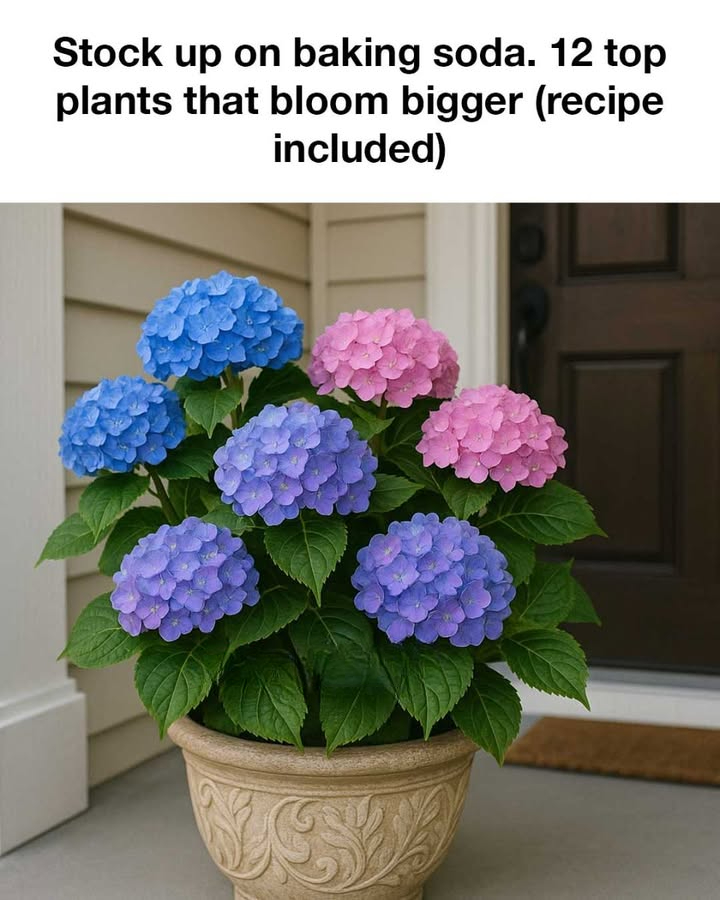Baking soda—also known as sodium bicarbonate—is more than just a kitchen staple. While it’s widely used to neutralize odors and clean everything from countertops to refrigerators, it’s also gaining recognition among gardeners for its remarkable benefits to plants. Affordable, natural, and eco-friendly, baking soda can work wonders in your garden by improving plant health, encouraging bigger blooms, and keeping diseases at bay.

Why Baking Soda Works in the Garden
The science behind baking soda’s gardening benefits lies in its chemical makeup. As a mild alkaline compound, it has the ability to balance overly acidic soil. Many plants prefer soil that’s neutral to slightly alkaline, and using baking soda helps create the ideal growing conditions. On top of that, baking soda has antifungal properties, making it useful in combating the fungal infections that often plague flowering plants.
When used properly, baking soda can help flowers thrive by increasing nutrient absorption, protecting them from disease, and even encouraging brighter, more vibrant blooms.
How Baking Soda Helps Your Flowers Flourish
Baking soda doesn’t just treat problems—it helps prevent them. When used regularly in the garden, it contributes to a healthier growing environment. Here’s how:
-
pH Balance: Many flowers flourish when soil isn’t too acidic. Baking soda helps regulate pH levels so roots can absorb key nutrients more effectively.
-
Disease Prevention: Fungal infections are a common issue for garden plants. Baking soda’s antifungal properties help keep leaves and blooms free of powdery mildew and similar problems.
-
Overall Plant Health: Healthy soil and disease-free foliage lead to stronger stems, better growth, and longer-lasting flowers.
10 Flowering Plants That Respond Well to Baking Soda
If you’re wondering which flowers will benefit most from a touch of baking soda, here are ten top picks that thrive with this natural remedy:
-
Begonias
These colorful, lush plants benefit from baking soda’s pH-balancing ability. With improved nutrient absorption, begonias can grow larger, bolder, and more vibrant blooms. -
Hydrangeas
This popular plant is especially sensitive to soil pH. Adding baking soda can push blooms toward beautiful pink hues, creating eye-catching, cheerful arrangements. -
Zinnias
Known for their long-lasting blooms and bold colors, zinnias love slightly alkaline soil. Baking soda helps maintain those conditions while keeping fungal diseases away for a healthier, longer blooming season. -
Petunias
Petunias offer extended blooming periods, and baking soda can help prolong that by fending off disease. It also supports general plant health, which means more flowers for a longer time. -
Geraniums
Geraniums benefit from baking soda by developing sturdier stems and fuller, more colorful flowers. These tougher plants also stand up better to temperature swings and pests. -
Roses
Beloved for their beauty and fragrance, roses flourish when soil conditions are just right. Baking soda not only wards off powdery mildew but also enhances scent and petal quality. -
Marigolds
Marigolds are famous for their natural pest-repelling traits. Baking soda helps these hardy plants stay disease-free, boosting their overall strength and effectiveness in the garden. -
Daisies
Simple and cheerful, daisies prefer soil that isn’t too acidic. Baking soda helps them absorb nutrients better and produce fuller, more numerous blooms. -
Lilies
With their elegant blooms, lilies benefit from baking soda’s disease-fighting properties. Healthier foliage and roots result in stronger growth and more abundant flowers. -
Chrysanthemums
These long-blooming favorites do even better with a little help from baking soda. By protecting against fungal infections and supporting vigorous growth, chrysanthemums can stay in bloom longer and look better doing it.
How to Use Baking Soda in Your Garden
Using baking soda in your garden is simple, but it’s important to get the mix right. Here’s a basic step-by-step method:
-
Make the Solution: Mix 1 tablespoon of baking soda with 1 gallon of water.
-
Apply to Soil: Pour the mixture at the base of your plants. This allows the baking soda to adjust the soil pH and benefit the roots directly.
-
Spray the Leaves (Optional): For added protection against fungal infections, you can spray the solution onto plant leaves. Just be sure to do this early in the morning or late afternoon to avoid sunburn.
-
Repeat Every Two Weeks: For best results, apply every two weeks during the growing season.
Tips and Precautions
While baking soda is generally safe for use in the garden, moderation is key. Too much can make the soil overly alkaline, which may harm plants rather than help them. To avoid issues:
-
Test Soil pH: Always check your soil’s pH before and after application. Most flowers prefer a pH between 6.0 and 7.5.
-
Avoid Overuse: Stick to the recommended amount and frequency.
-
Don’t Spray in Direct Sunlight: This can lead to leaf burn, especially on delicate plants.
-
Watch for Signs of Stress: If plants start to yellow or wilt, reduce baking soda usage.
Final Thoughts: A Natural Boost for Your Garden
Baking soda is a surprisingly powerful ally for home gardeners. Whether you’re aiming for larger roses, brighter hydrangeas, or longer-lasting chrysanthemums, this common kitchen item offers big benefits with minimal effort. With its ability to improve soil conditions, prevent diseases, and enhance overall plant health, baking soda is a smart, budget-friendly addition to any gardener’s toolkit. Just remember to use it wisely, and your flowers will reward you with bigger, bolder, and more beautiful blooms all season long.





